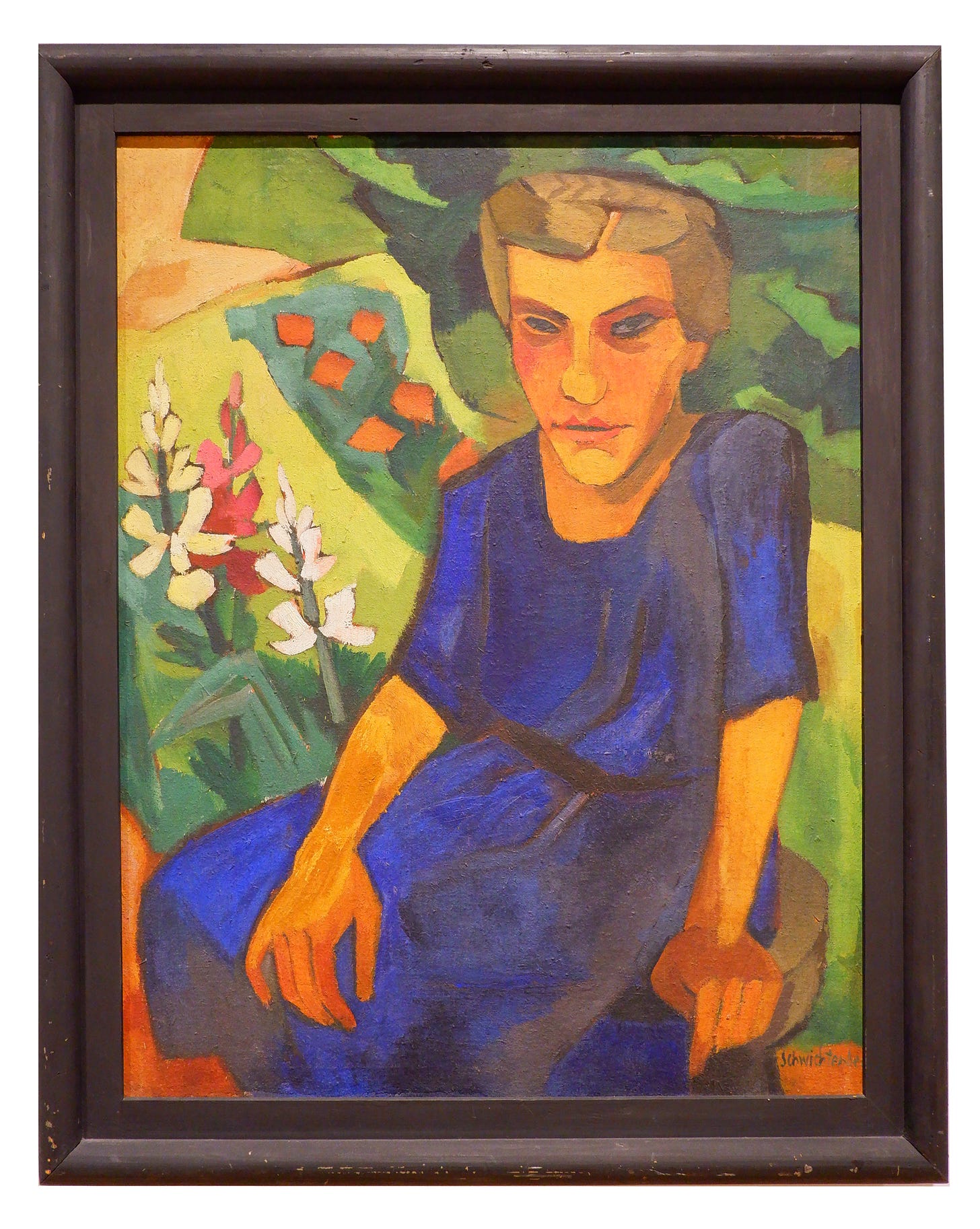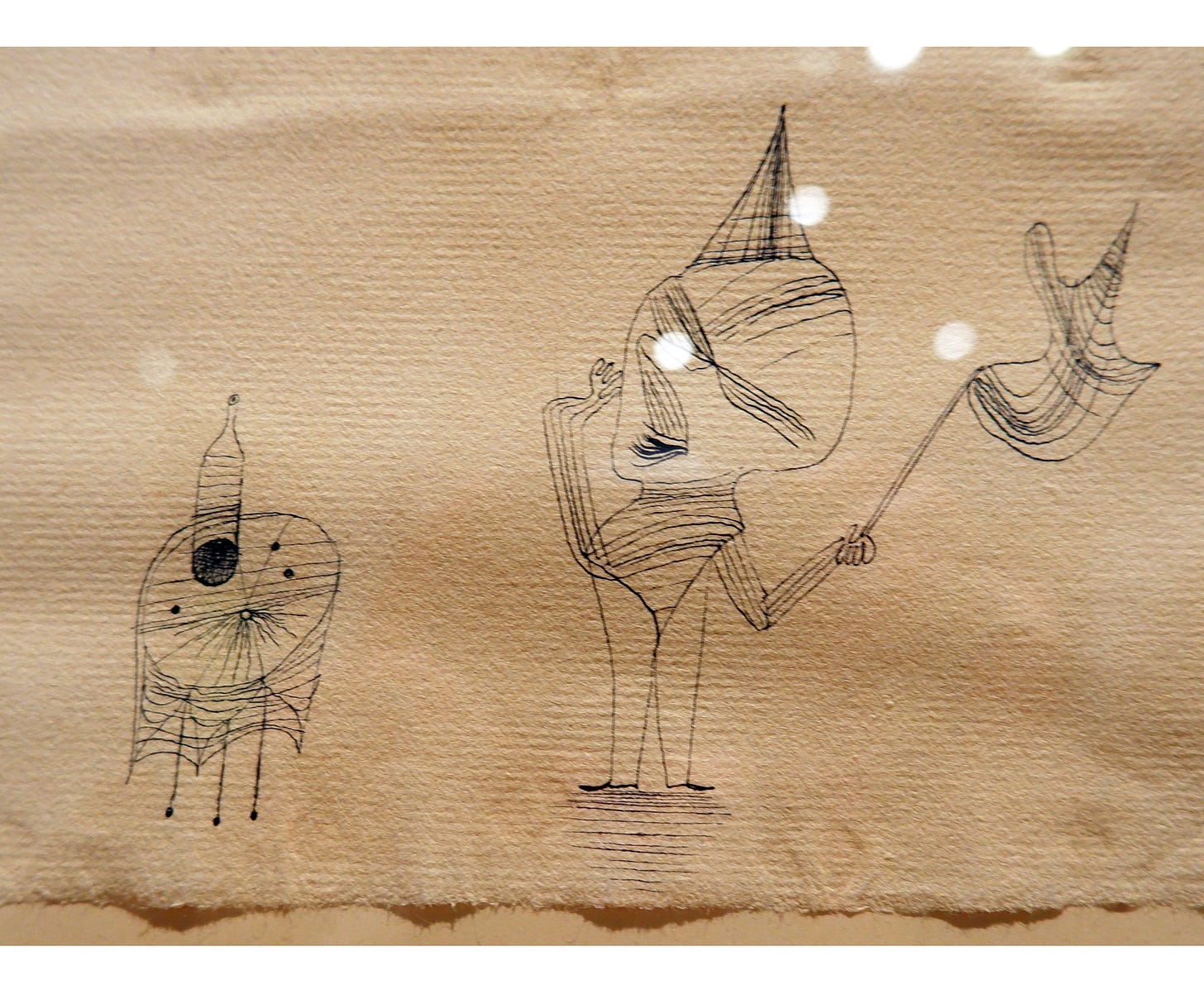This week, I had the pleasure of touring the Maltz Museum’s “DEGENERATE!” exhibit, which will only run through the end of this week. I’d been dragging my feet about getting there, but the weather was completely abysmal on Tuesday, so I went with my mother. She had already seen the exhibit but wanted to go again. She’s so kind about me: “the docent we had was wonderful and I enjoyed the tour, but I want you to give me a tour as well.” So, off we went for mother-daughter art history time!
I had not visited the museum for several years (I believe I was last there just before the great covid catastrophe.) I had forgotten how large and beautiful the facility is. In addition to the art gallery, there is a history wing detailing the immigration history of the Cleveland area and the many contributions of the Jewish people who settled here in the last century and before. This wing leads into a holocaust history area, a space dedicated the the diaspora, another to the collapse of 20th century communism and ending in a lovely room featuring the cultural and scientific contributions of Cleveland’s current Jewish community. It’s truly a trove of local history, even if you are not directly associated with Jewish culture. Where else are you going to see an antique Hebrew typewriter!?
I learned from the nice lady at the front desk that the art exhibit originated at the Jewish Museum Milwaukee and was not necessarily intended to travel but will be going on the road. Hopefully it will come to a cultural center near you! It intends to highlight the contribution of Jewish and dissident artists to modern art while calling attention to Nazi Germany’s cultural erasure of developing styles.
The early to mid 20th century’s cultural upheaval is reflected in its art. It’s easy to forget how completely new these styles were- post impressionism, constructivism, expressionism, fauvism and cubism were absolutely celebrated as innovation in some places and decried as degeneracy in others. We see Picasso, Beckmann, Chagall and Ernst at every museum we visit. Since the impressionists, fringe creators had been carving a space out for themselves in pre-gentrified slums, jazz clubs, street corners and the private residences of fellow iconoclasts. The art world did its best to turn the other way and ignore, but not Hitler. Hitler was bent on removing these influences from public view and replacing them with what we would now call “heroic realism.” The reich was a place of conscientious visual branding and the art featured in DEGENERATE! could have no place at the table. We know now what happened, but it’s easy to wonder if the people who attended the event for which this exhibit is named had any idea what was about to happen.
Hitler’s toadies confiscated art from private and public collections alike, culminating in his 1937 “Degenerate Art Show.” This show featured over 600 modernist works and ran alongside the “Great German Art Exhibition” showcasing more acceptable and nationalist pieces. Many of the works were destroyed and many of the artists were sent to labour camps or run out of the country. All art history students learn about this and shudder to think “that could have been me, if I simply made the ‘wrong’ woodblock print.” I assume the entire affair is news to the general public, which seems ever anxious to forget the ugliest parts of our history.
I asked my mum where she would like to start. “At the beginning, of course.” So we watched a flickery projection of the old film reels showing Germans visiting the original show. I got close to the wall and began pointing out artists and works that I recognised. Probably too loudly, as I am almost always a nuisance at the art museum. Then we began our walk through the extensive exhibit which was divided into cultural and stylistic themes. We discussed everything from how lithograph prints work to the women of the Bauhas. We marveled at how so many beautiful works would have been considered unacceptable. I squealed with delight when I saw some works by Kathe Kollwitz and we compared the fauvist way of using colour and shape to the impressionist way. Mum: “I guess I never realised how different they are!” Below are some of the art we liked the best and my comments. Please enjoy and do try to get to the museum if you can!
“The Letter,” Karl Hofer: this is part of the permanent collection at the Cleveland Museum of Art. Probably this doesn’t seem shocking our outrageous to your post modern eyes. The New Objectivist movement focused unsentimental reality. The treatment of the paint highlights the young woman’s focus on the letter- her face, hands and the letter itself are the only parts of the painting that would have appeared “finished” to it’s contemporary viewers. The Letter was painted just before Hofer was declared a degenerate.
“Seated Woman with Flowers,” Martel Schwichtenberg is on loan from the Haggerty Museum of Art. I practically ran to this painting. “Mama! She looks like Babcia!” to which I was told, “Babcia didn’t have shat sharp of a chin, but I can see why you would think that looks like her. The hair, the hands.” Honestly I think it is more of the “I’ll do what I want” look she’s giving the viewer!
“Untitled Woman,” George Grosz, on loan from the Warehouse Art Museum was the only sepia ink drawing at the exhibit. My mum asked what makes it “sepia” which was a question I have honestly never been asked. The only important answer there is “it’s brown.” Sepia is a kind of brown art ink which is made from biological ink extracted from the sacs of cuttlefish… because sometimes art supplies are yucky. We both really admired this one- I liked the line work in the hands and face. I thought she was doing embroidery until mum pointed out she’s actually writing a letter.
“Woman with Babushka,” Ernst Fritsch is another New Objectivist portrait on loan from the Haggerty Museum. Again we can see the juxtaposition of fine detail foreground on almost unfinished looking background. I like her!
“Death Seizes a Woman,” Kathe Kollwitz, is on loan from MoMa. Kathe is a particularly fascinating artist for me. She was originally from Prussia and her maiden name was Schmidt. I’ve always wondered if she is a distance relative of my grandfather. She worked in “cycles,” which were series or portfolios on a theme. “Death” was the last of her projects, although war, death, suffering and the macabre feature in most of her work. Her prints land somewhere between expressionism and realism. DEGENERATE! featured several of her works, including a bronze cast.
“Joyful Ascent,” Vasily Kandinsky, on loan from MoMA… Kandinsky is one of the better known Bauhaus artists. Bahaus was actually an art collective which sought to combine industrial design and fine art and not just a rad punk rock band form the 70s (cue the more you know music.) Less concerned with life in traditional arts academies, they set their school up as an apprenticeship system and considered themselves a crafts guild. The Nazis shut them down (along with the rest of the New Objectivist groups) although many instructors fled to Chicago and reestablished the school.
And what would a trip to an exhibit like this be if I didn’t get to stop and admire my favourite “Little Sorcerer” / Bauhaus teacher Paul Klee!? This one is on loan from the University of Wisconsin-Milwaukee Art Collection. Whimsical geometric abstractism may not be your bag, but I love the playfulness of it. Klee was also a musician- intellectually curious, playful and analytical. Many of his works were featured in the original Nazi degenerate show… I imagine because everything about Klee and his work is completely antithetical to that particular ethos. He is famous for saying “becoming is superior to being” and “a line is a dot that went for a walk.”
Me, pretending to be the subject of this painting. She’s better looking!
I have a last note about the Maltz Museum, for those of you who have stuck around all the way to the end. It is personal and I suppose also political. But it is mine.
At any given time in the museum, I saw at least a half a dozen security guards. Serious looking security guards, not museum guys who tell you not to lick the Salvador Dali paintings. That’s true story: I was ejected from the Guggenheim. I’ll tell you about it sometime. These were for real- armed guards wearing flak vests. They are present from the moment you walk in the door (or rather the guard lets you in by unlocking the door for you to both enter and exit the building.) On the floor, in the parking lot, at the front desk. I would typically be annoyed by this type of thing, but in this case I understand.
Since the events of October 7th 2023 there has been a rise in attacks on Jewish cultural centers and places of worship, even here in peaceful Northeast Ohio. I suppose I took for granted most of my life that this type of thing was rare and kept itself to gross online chat boards populated by miserable old men grooming insecure young men into the ranks of neo-antisemitism. The fact that I made it to almost 43 years of age without ever hearing the word “Zionist” used as a slur (much less be called a “dirty Zionist bitch” straight to my face) was a luxury I did not appreciate. Never in the first 43 years of my life did I hold the belief that anyone looked at certain friends or members of my family differently because their religious calendar is a little older.
So, thanks, to those guys, for protecting the people and the treasures at the museum, where I am pleased to announce I am now officially a member.










